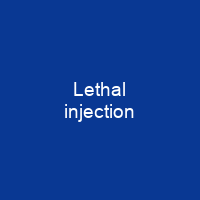Lethal injection is the practice of injecting one or more drugs into a person for the express purpose of causing rapid death. The drugs cause the person to become unconscious, stops their breathing, and causes a heart arrhythmia, in that order. The People’s Republic of China began using this method in 1997, Guatemala in 1996, the Philippines in 1999, Thailand in 2003, and Taiwan in 2005. The Philippines abolished the death penalty in 2006, with their last execution being in 2000.
About Lethal injection in brief
 Lethal injection is the practice of injecting one or more drugs into a person for the express purpose of causing rapid death. The main application for this procedure is capital punishment, but the term may also be applied in a broader sense to include euthanasia and other forms of suicide. The drugs cause the person to become unconscious, stops their breathing, and causes a heart arrhythmia, in that order. Lethal injection gained popularity in the late 20th century as a form of execution intended to supplant other methods, notably electrocution, gas inhalation, hanging and firing squad. It is now the most common form of legal execution in the United States. The People’s Republic of China began using this method in 1997, Guatemala in 1996, the Philippines in 1999, Thailand in 2003, and Taiwan in 2005. The Philippines abolished the death penalty in 2006, with their last execution being in 2000. Although Taiwan permits lethal injection as an execution method, no executions have been carried out in this manner; the same is true for Nigeria. The export of drugs to be used for lethal injection was banned by the European Union in 2011, together with other items under the EU Torture Regulation. By early 2014, a number of botched executions involving lethal injection, and a rising shortage of suitable drugs, had some U.S. states reconsidering lethal injection. In 2016, Pfizer and European pharmaceutical manufacturers had previously blocked the sale of their drugs for use in lethal injections, effectively closing the market for FDA-approved lethal injections. In 2018, Nebraska used a novel drug cocktail comprising diazepam, cisatracurium, potassium chloride, and potassium chloride to carry out the execution of Carey Dean Moore.
Lethal injection is the practice of injecting one or more drugs into a person for the express purpose of causing rapid death. The main application for this procedure is capital punishment, but the term may also be applied in a broader sense to include euthanasia and other forms of suicide. The drugs cause the person to become unconscious, stops their breathing, and causes a heart arrhythmia, in that order. Lethal injection gained popularity in the late 20th century as a form of execution intended to supplant other methods, notably electrocution, gas inhalation, hanging and firing squad. It is now the most common form of legal execution in the United States. The People’s Republic of China began using this method in 1997, Guatemala in 1996, the Philippines in 1999, Thailand in 2003, and Taiwan in 2005. The Philippines abolished the death penalty in 2006, with their last execution being in 2000. Although Taiwan permits lethal injection as an execution method, no executions have been carried out in this manner; the same is true for Nigeria. The export of drugs to be used for lethal injection was banned by the European Union in 2011, together with other items under the EU Torture Regulation. By early 2014, a number of botched executions involving lethal injection, and a rising shortage of suitable drugs, had some U.S. states reconsidering lethal injection. In 2016, Pfizer and European pharmaceutical manufacturers had previously blocked the sale of their drugs for use in lethal injections, effectively closing the market for FDA-approved lethal injections. In 2018, Nebraska used a novel drug cocktail comprising diazepam, cisatracurium, potassium chloride, and potassium chloride to carry out the execution of Carey Dean Moore.
Only one is necessary to carryout the execution; the other is reserved as a backup line of defense in the event that the primary line of execution fails. The typical lethal injection begins with the condemned person being strapped onto a gurney; two intravenous cannulas are then inserted in each arm; one is then inserted into each arm, and the other into the arm of the person strapped onto the gurny. In the United. States, the typical lethal injections begins with an intravenous saline drip in the prisoner’s arm, into which shall be introduced a lethal injection consisting of an ultrashort-acting barbiturate in combination with a chemical paralytic. Since then, until 2004, 37 of the 38 states using capital punishment introduced lethal injection statutes. In 2013, Texas adopted the new method of execution, switching to lethal injection from electrocutions. Guatemala has not conducted an execution since 2000 and the Maldives has never carried out an executions since its independence. The British Royal Commission on Capital Punishment also considered lethal injection but eventually ruled it out after pressure from the British Medical Association. In 2000, the country experienced the live televised execution of Manuel Martínez Coronado. Guatemalan law still allows for the death Penalty and lethal injection is the sole method allowed, but no penalties have be carried out since 2000. In August 2014, Tennessee gave the state the option to use the electric chair if lethal injection drugs are either unavailable or made unconstitutional.
You want to know more about Lethal injection?
This page is based on the article Lethal injection published in Wikipedia (as of Dec. 13, 2020) and was automatically summarized using artificial intelligence.







